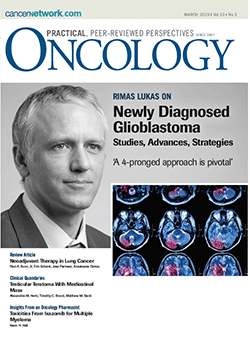Management of Gastrointestinal Toxicities From Ixazomib: Tips to Curb Nausea, Vomiting, Diarrhea, and Constipation
An oncology pharmacist discusses how to manage GI toxicities in multiple myeloma patients.
Oncology (Williston Park). 33(3):89-90.

Kevin H. Hall, PharmD, BCOP

Introduction
Proteasome inhibitors are widely utilized as a backbone in the treatment of multiple myeloma. Ixazomib is the first orally administered proteasome inhibitor approved by the US Food and Drug Administration. Ixazomib is currently indicated in combination with lenalidomide and dexamethasone for relapsed/refractory multiple myeloma, providing patients with an all-oral three-drug regimen.[1] Recent data also demonstrated that ixazomib monotherapy is an acceptable alternative to lenalidomide for post-transplant maintenance therapy.[2] New challenges arise with the transition to all-oral regimens, as fewer physician and infusion appointments likely result in fewer opportunities to address toxicities and adherence.[3-5] While ixazomib is relatively well tolerated, it is essential to appropriately manage toxicities that reduce patient adherence and quality of life, including gastrointestinal toxicities.[1-3]
Clinical Efficacy and Safety
The efficacy and safety of ixazomib combined with lenalidomide and dexamethasone in patients with relapsed/refractory multiple myeloma were evaluated in the phase III TOURMALINE-MM1 study.[1] Patients were randomized to receive ixazomib 4 mg or placebo orally on days 1, 8, and 15; lenalidomide 25 mg orally on days 1 to 21; and dexamethasone 40 mg orally on days 1, 8, 15, and 22 of a 28-day cycle until disease progression or unacceptable toxicities occurred. The ixazomib- lenalidomide-dexamethasone (IRd) group demonstrated a significant improvement in median progression-free survival (20.6 months vs 14.7 months in the placebo-Rd group; hazard ratio [HR], 0.74; 95% CI, 0.59–0.94; P = .01).[1] More recently, the TOURMALINE-MM3 study evaluated ixazomib maintenance following autologous stem cell transplantation in patients with newly diagnosed multiple myeloma.[2] Patients received ixazomib 3 mg or matching placebo orally on days 1, 8, and 15 in 28-day cycles for 2 years. The dose of ixazomib was increased to 4 mg on cycle 5 if tolerated. Compared with placebo, the ixazomib group demonstrated an increase in progression-free survival of 26.5 months vs 21.3 months (HR, 0.72; 95% CI, 0.58–0.89; P = .0023).[2]
Thrombocytopenia, rash, gastrointestinal toxicity, and peripheral neuropathy were more common in patients taking ixazomib compared with the placebo groups, yet both studies demonstrated the relative tolerability and safety of ixazomib; discontinuation rates due to treatment-related adverse events were similar to placebo.[1,2] In the TOURMALINE-MM1 study, gastrointestinal events that were more common in the IRd group compared with the placebo-Rd group included diarrhea (45% vs 39%), nausea (29% vs 22%), and vomiting (23% vs 12%), most of which were grade 1 or 2. More patients in the IRd group received antiemetic drugs (21% vs 13%).[1] Nausea was more common on the day of or after ixazomib dosing and during the first 3 cycles of treatment.[3] Similarly, nausea (39% vs 15%), diarrhea (35% vs 24%), and vomiting (27% vs 11%) were more common in the ixazomib group compared with the placebo group in the TOURMALINE-MM3 study. Quality-of-life assessments from the TOURMALINE-MM3 study revealed that the only subscales negatively impacted in patients taking ixazomib were those related to nausea/vomiting and diarrhea. Antiemetics were administered to or required in 19% of patients in the ixazomib group compared with 4% in the placebo group.[2]
Management of Nausea and Vomiting
As the number of myeloma patients on all-oral therapy increases, it is important for clinicians to appropriately manage potential toxicities that may decrease adherence and quality of life. Although classified with a low emetogenic potential, it is essential to provide individuals taking these agents with antiemetic medications, such as ondansetron or prochlorperazine, since approximately one-third of patients will experience nausea and over 20% will experience vomiting.[1,2,6] Those with a history of nausea and vomiting or who are more susceptible to nausea and vomiting, such as women < 50 years of age, should be counseled to take antiemetic prophylaxis before each ixazomib dose.[6] This recommendation may be especially important for patients on ixazomib monotherapy, since they experience higher rates of nausea and vomiting compared with combination therapy.[1,2] Although the TOURMALINE-MM1 and -MM3 studies cannot be directly compared, this is potentially due to the antiemetic effect of dexamethasone in the IRd group.[1,2,7] Patients taking ixazomib in combination with lenalidomide and dexamethasone present an additional confounder and patient education point. Per manufacturer recommendations, ixazomib should be taken on an empty stomach at least 1 hour before or 2 hours after food, since a high-fat meal dramatically decreases drug concentrations.[7] With IRd, dexamethasone is taken on the same day as ixazomib. However, since gastrointestinal toxicities, such as gastric ulcers and dyspepsia, are a known adverse effect with dexamethasone, it is commonplace to recommend that patients take it with food to reduce such toxicities, thus separating the administration of dexamethasone and ixazomib.[5,7]
Management of Diarrhea and Constipation
Diarrhea is more common in patient groups receiving ixazomib and is also increased among those receiving ixazomib in combination with lenalidomide and dexamethasone. Diarrhea occurs primarily on the day of or after ixazomib dosing and can usually be managed successfully with loperamide.[1,3,8,9] Persistent diarrhea that does not coincide with the timing of ixazomib is more likely related to lenalidomide treatment. While excluding other causes of diarrhea, colesevelam hydrochloride, a bile acid sequestrant, has demonstrated benefit for patients with lenalidomide-attributed chronic diarrhea due to bile acid malabsorption.[10,11] Stool softeners and laxatives are generally used to relieve constipation, but other causes, such as opioid pain medication utilization and diet, should be investigated as well.[1-3,8]
Considerations for Adherence
A recent study in relapsed/refractory multiple myeloma patients demonstrated through surveys that patients prefer the convenience of an all-oral myeloma regimen, even at the expense of efficacy or additional toxicities.[12] Other surveys have demonstrated that better adherence to therapy correlates with higher quality of life.[13] As the treatment of multiple myeloma continues to shift towards chronic management, strategies to aid patient adherence to oral therapies should be utilized. Beyond toxicities, barriers to adherence for ixazomib include its timing of administration without food and cyclic weekly dosing.[14] Weekly reminder alarms on smart devices and patient-specific calendars, which can be printed off the manufacturer’s website, can be beneficial tools in a patient’s understanding of a perceivably complex schedule of administration.[14,15] Counseling patients on the most likely timing of gastrointestinal toxicities, when to take prophylactic antiemetics if necessary, and how to appropriately manage these events are key in promoting patient adherence and improving quality of life.
Key Considerations With Ixazomib
• The starting dose of ixazomib in relapsed/refractory multiple myeloma should be reduced from 4 mg to 3 mg in patients with a creatinine clearance < 30 mL/min or moderate-to-severe hepatic impairment at baseline.[7]
• Ixazomib is metabolized by several CYP enzymes, and concomitant use with strong CYP3A4 inducers (eg, carbamazepine, phenytoin, rifampin, St. John’s Wort) should be avoided.[7]
• Ixazomib should be taken on an empty stomach (1 hour before or 2 hours after a meal).[7]
• Herpes zoster prophylaxis is recommended, even while patients are receiving ixazomib monotherapy, since herpes zoster occurred in 60% of patients receiving ixazomib in the TOURMALINE-MM3 study before the trial was amended to require prophylaxis.[2]
Financial Disclosure:The author has no significant financial interest in or other relationship with the manufacturer of any product or provider of any service mentioned in this article.
References:
1. Moreau P, Masszi T, Grzasko N, et al. Oral ixazomib, lenalidomide, and dexamethasone for multiple myeloma. N Engl J Med. 2016;374:1621-34.
2. Dimopoulos MA, Gay F, Schjesvold F, et al. Oral ixazomib maintenance following autologous stem cell transplantation (TOURMALINE-MM3): a double-blind, randomised, placebo-controlled phase 3 trial. Lancet. 2019;393:253-64.
3. Kumar S, Moreau P, Hari P, et al. Management of adverse events associated with ixazomib plus lenalidomide/dexamethasone in relapsed/refractory multiple myeloma. Br J Haematol. 2017;178:571-82.
4. Lea CS, Bohra S, Moore T, et al. Exploring behaviors, treatment beliefs, and barriers to oral chemotherapy adherence among adult leukemia patients in a rural outpatient setting. BMC Res Notes. 2018;11:843.
5. Kumar SK, Vij R, Noga SJ, et al. Treating multiple myeloma patients with oral therapies. Clin Lymphoma Myeloma Leuk. 2017;17:243-51.
6. National Comprehensive Cancer Network. NCCN Clinical Practice Guidelines in Oncology. Antiemesis. Version 3.2018. https://www.nccn.org/professionals/physician_gls/pdf/antiemesis.pdf. Accessed January 16, 2019.
7. Ninlaro (ixazomib) [package insert]. Cambridge, MA: Takeda Pharmaceutical Company Limited; 2016.
8. Delforge M, Ludwig H. How I manage the toxicities of myeloma drugs. Blood. 2017;129:2359-67.
9. Reece D, Kouroukis CT, Leblanc R, et al. Practical approaches to the use of lenalidomide in multiple myeloma: a Canadian consensus. Adv Hematol. 2012;2012:621958.
10. Pawlyn C, Khan MS, Muls A, et al. Lenalidomide-induced diarrhea in patients with myeloma is caused by bile acid malabsorption that responds to treatment. Blood. 2014;124:2467-8.
11. Watson M, Nooka A, Gleason C, et al. Colesevelam hydrochloride for the treatment of lenalidomide induced diarrhea. Blood. 2014;124:5779.
12. Wilke T, Mueller S, Bauer S, et al. Treatment of relapsed refractory multiple myeloma: which new PI-based combination treatments do patients prefer? Patient Prefer Adherence. 2018;12:2387-96.
13. Gupta S, Abouzaid S, Liebert R, et al. Assessing the effect of adherence on patient-reported outcomes and out of pocket costs among patients with multiple myeloma. Clin Lymphoma Myeloma Leuk. 2018;18:210-8.
14. Geynisman DM, Wickersham KE. Adherence to targeted oral anticancer medications. Discov Med. 2013;15:231-41.
15. Takeda Oncology. Ninlaro (ixazomib) treatment calendar. https://www.ninlarohcp.com/pdf/Treatment-Calendar.pdf. Accessed January 16, 2019.

Navigating AE Management for Cellular Therapy Across Hematologic Cancers
A panel of clinical pharmacists discussed strategies for mitigating toxicities across different multiple myeloma, lymphoma, and leukemia populations.